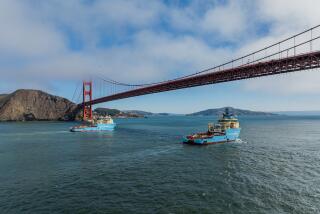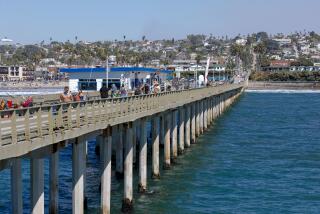Tsunami debris: Oregon workers begin slicing up Japanese dock
A salvage company Wednesday made the first cuts into a 165-ton Japanese dock that ripped from its moorings during last year’s tsunami and washed onto an Oregon beach in June.
Think of the dock’s demolition as a concrete pound cake being sliced with a cable instead of a knife.
The crew will cut the 66-foot dock into five pieces and lift the chunks onto flatbed trucks for removal, officials said. A blue-painted ocean wave mural that appeared this week on one section of the dock will be preserved for a memorial in honor of the March 2011 victims of the earthquake and tsunami off Japan.
The dock had been beached like some bulky alien vessel since it came ashore June 5 north of Newport, Ore. The floating behemoth, which began life in a prefecture of northern Japan, is the most dramatic example of what scientists say could be more than a million tons of tsunami debris adrift in the Pacific.
The dock didn’t sink for one reason: It’s Styrofoam inside, as are many docks, said Chris Havel, spokesman for the Oregon Parks and Recreation Department.
Dozens watched as workers prepared for a complicated and expensive excavation process. It seemed like slow-going to onlookers. But if all goes according to schedule, Havel told The Times, the dock will be sliced and removed by the end of the day Thursday.
“People are finally starting to wander off,” he said. “But they’ll be back. They don’t see something like this every day.”
The other option besides demolition was towing the dock back to sea, Havel said, but Japan didn’t want the dock back and demolition was cheaper. It had come ashore bearing various invasive species, which volunteers scraped off and buried before sterilizing the dock with torches, the Associated Press reported.
The Parks and Recreation Department is footing the $84,000 bill – the lowest price quoted in the bidding process – but is seeking financial help from state and federal agencies, Havel said.
On Monday and Tuesday, workers prepared for the demolition by digging the sand from around the dock and wedging PVC pipe underneath. They fed a diamond-coated cable through the piping and circled it around the dock, closing the loop by attaching the ends to a motor atop the dock.
When the motor whirred, the cable loop tightened, slowly cutting from the bottom up.
A crane will hook each section, weighing 32 to 34 tons, and lift it onto a truck. When the dock leaves the beach, Havel said, it becomes the property of the salvage company.
Ballard Diving and Salvage of Vancouver, Wash., plans to drive the pieces to Portland for disposal, Havel said. The Styrofoam can’t be recycled, but the concrete and steel will be.
The materials that once held a dock together at the Japanese port of Misawa may start life anew as gravel topping on a road stretching through Oregon.
ALSO:
Shark bite victim will be swimming closer to shore
As drought widens, 50.3% of U.S. counties declared disaster areasPinnacles National Monument could become U.S.’ 59th national park
Join Laura on Google+ and Twitter. Email: laura.nelson@latimes.com
More to Read
Sign up for Essential California
The most important California stories and recommendations in your inbox every morning.
You may occasionally receive promotional content from the Los Angeles Times.











